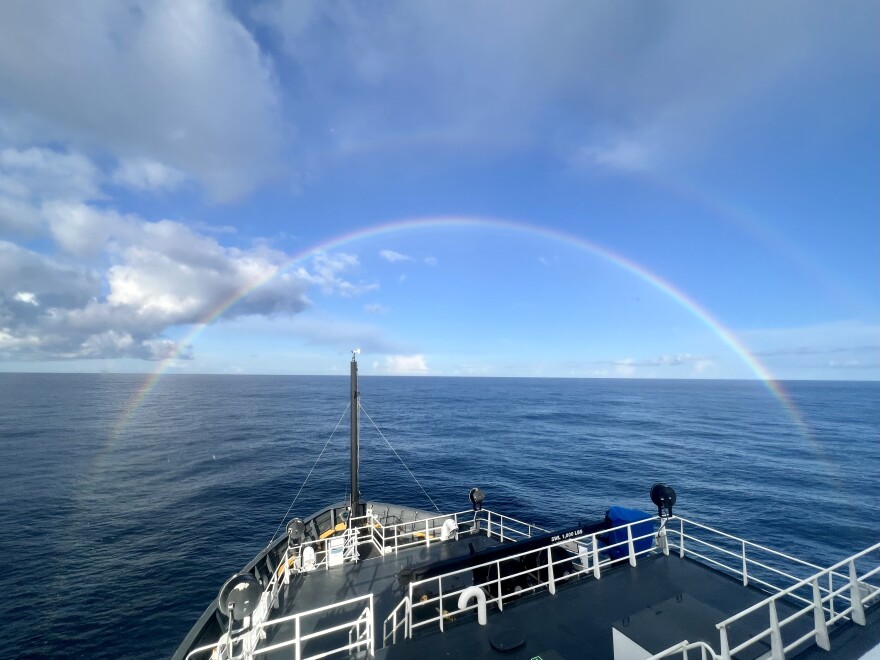
- First of three parts. Tuesday, July 5: Watching for whales
By COURTNEY FLATT/Northwest Public Broadcasting
NEWPORT — At least twice a year, a team of scientists on the research vessel Bell M. Shimada survey waters along the Washington and Oregon coast.
Near the edge of the coastal shelf, off the shore of Grays Harbor, Wash., a 10-foot-long net the shape of two bongo drums slowly lowered into the inky black sea. Down 10 meters. Down 20 meters.
Waves knock against the ship. For a few moments, the scientists aboard the National Oceanic and Atmospheric Administration ship wondered what sea life these nets might catch.
The place where salmon spend most of their lives also is the place scientists know the least about — the ocean.
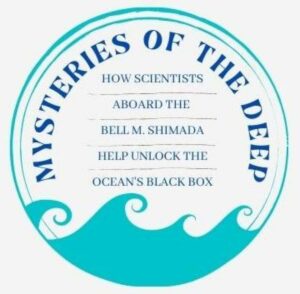
To help scientists learn more about ocean conditions and how those conditions affect salmon and other marine life, researchers took to the high seas in May aboard the Newport-based Bell M. Shimada to study ocean conditions and the tiny organisms that fish such as salmon, sablefish and sardines eat in the ocean.
For salmon, years spent in the ocean mark critical points in the lives of salmon, scientists said.
“I think it’s important that we all think about the ocean, especially for salmon. That really is where they get big. It’s clearly an important part of their lifecycle, but we just kind of take it for granted. It’s out of sight, out of mind,” said Laurie Weitkamp, a Newport-based research fisheries biologist with the National Oceanic and Atmospheric Administration.
Scientists have sampled areas of the Oregon and Washington coasts for 20 years. Last year saw some of the best ocean conditions in more than 20 years for salmon, although scientists are less sure about what ocean conditions right now will bring.
The survey on the Shimada allows scientists to sample more of the Northern California Current ecosystem, from Trinidad Head in California to La Push in Washington. The California Current is one of the most productive regions in the ocean because of wind-driven upwelling that delivers nutrient rich water to the Continental Shelf, Fisher said.
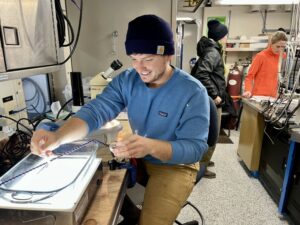
One scientist aboard the NOAA ship, Kris Bauer, hoped to find tiny crustaceans known as copepods. These “copes,” as Bauer affectionately calls them, play an integral part in the ocean’s food web, filling the bellies of juvenile salmon, sardines and tuna.
“Different species of salmon and tuna and rockfish, they all target these larger copepods because they give fish so many more calories for the effort that they’re expending to hunt,” said Bauer, a second-year Ph.D. student in Oregon State University’s department of integrated biology.
However, climate change could cause big swings in ocean conditions, leaving these tiny copepods to face an inhospitable environment, including warmer, more acidic and increasingly hypoxic waters, which don’t carry all the oxygen that sea life needs to thrive.
It’s unclear exactly what that will mean for hungry, growing fish that feed on copepods. But, some scientists worry a future shifting food web, which could reduce the number of copepods, could further diminish the number of salmon returning to spawning grounds.
These types of changing ocean conditions have other scientists on land wondering whether efforts to save salmon could be for naught. Moreover, some scientists said ocean conditions must be taken into consideration when evaluating how to save salmon.
Effects on salmon
When young salmon first enter the ocean, it’s one of the most important times in their lives, when they bulk up on copepods and grow stronger.
“I think it’s important that we all think about the ocean, especially for salmon,”said Weitkamp. “That really is where they get big. It’s clearly an important part of their lifecycle, but we just kind of take it for granted. It’s out of sight, out of mind.”
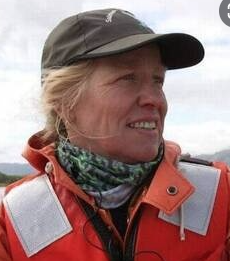
However, the time salmon spend in the ocean leaves many unanswered questions for scientists, Weitkamp said.
“Right now we don’t understand very much, and we feel like, maybe there really are some critical things that we can be doing that would benefit salmon. But we don’t know what those are at this moment because the ocean is just a big black box,” Weitkamp said.
Salmon spend much of their lives in the ocean, and most of them don’t make it back inland to spawn.
Take the endangered spring/summer chinook on the Snake River. Only about 1% of those salmon that make it to the ocean survive, said Brian Burke, a supervisory research fish biologist with NOAA’s Northwest Fisheries Science Center.
“If we could change ocean survival from 1% to 2% on average, that would dramatically change the entire situation,” Burke said.
Moreover, studies suggesting any single measure to save salmon in freshwater, like increased spill over dams or dam removal, must incorporate data from the years salmon spend at sea, Burke said.
“All of these things we’re doing in freshwater, it would not be a good strategy to interpret the results of these management actions without understanding the impacts of the ocean,” he said.
To that end, the scientists need to better understand predation in the ocean, Burke said. What animals eat juvenile salmon, how much salmon they eat, as well as when and where.
Right now, scientists rely more on a variety of ocean indicators such as surface temperature, which can affect the amount of food available for young salmon to eat. Those indicators, like copepod productivity, provide invaluable information, Burke said, but it all tends to correlate to salmon survival not drive it.
To help answer some of those questions, NOAA’s Northwest Fisheries Science Center is drafting a strategy document that could guide future salmon predation studies, Burke said.
Unraveling the ocean’s mysteries
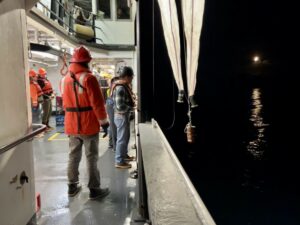
Out at sea, many tiny zooplankton, which include copepods, come alive at night, when they’re less likely to end up in the jaws of larger sea creatures. Under the cover of darkness, the zooplankton can more safely migrate to the upper water columns to catch some dinner of their own.
Now close to the surface, Bauer hoped to catch copepods in the ship’s bongo nets. For one experiment, he planned to catch live copepods to study in a lab on-shore.
“It’s cool to see them preserved, but when they’re alive, and you see them moving around, and feeding and swimming. No matter how tired I am, it’s always the coolest part,” Bauer said.
The scientists are part of a May 6-17 expedition along California, Oregon and Washington waters, ultimately traveling 1,718 nautical miles. On this survey expedition, the scientists collected samples of zooplankton, phytoplankton, environmental-DNA, and tested water salinity. The boat cut through water swells up to 13-feet and 40-knot winds deemed dangerous enough to stop sampling efforts. Scientists laughed as a pod of roughly 60 dolphins played in the Shimada’s wake and jumped in excitement at the sight of a sei whale, less frequently identified in these waters.
They hoped all their efforts will help unravel a few threads of the scientific mysteries and secrets the ocean and its creatures hold tight.
For example, Bauer has more questions than answers surrounding the copepods he’s studying. His adviser, Felipe Barreto, who studies a completely different intertidal copepod species, jokes that the 5-millimeter crustaceans Bauer studies are “real copepods” because of their size.
In particular, Bauer is studying Calanus marshallae, a fatty copepod that many fish like to snack on. Calanus marshallae thrive in waters along the Gulf of Alaska to waters off British Columbia, Washington, and Oregon.
But first on the Shimada, Bauer had to catch the Plankton-like copepods.
Bauer uses copepods to study evolution in the ocean, particularly in response to climate change and oxygen changes on the coastal shelf. Unlike sea life such as fish and whales that are more mobile, he said, plankton can’t just pick up and go somewhere else.
“That’s the thing about plankton. They don’t really have the ability to move when conditions are stressful, unlike fish that are highly mobile and can escape these stressful conditions. Plankton have to endure them,” Bauer said.
But sometimes, ocean conditions bode well for these tiny creatures and the fish that eat them.
Winter conditions stick around
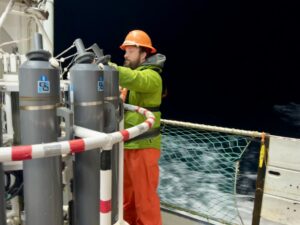
An early, nutrient rich-upwelling in 2021 brought cold waters from deep in the ocean to the coastline. Last year’s upwelling created some of the best ocean conditions in the last 20 years, supplying a bounty of fish food, including copepods.
However, on this leg of the Shimada’s expedition, the upwelling hadn’t yet arrived. Upwellings usually arrive around April 15, said Jennifer Fisher, a zooplankton ecologist with NOAA.
As the Shimada maneuvered along the Oregon and Washington coasts, sample after sample showed fewer thriving sea creatures than the previous spring, likely because the 2022 upwelling took its time arriving, Fisher said.
Prior to the survey, forecasting showed ocean spring conditions would start at the beginning of May. The ocean in early May still resembled winter conditions.
“The question still remains: when will the winds turn around? And what’s that going to do to the ecosystem?” she said.
Seeing what, exactly, is happening on the ocean is one reason long-term surveys like these are incredibly important, Fisher said. By June, Fisher said the delayed upwelling had finally come in, although was weaker than normal.
Decades of work
With the help of these surveys, scientists keep trying to unlock the mysteries of the tiny copepods, even after decades of previous work.
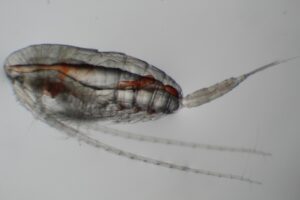
More than 42 years ago, the Calanus marshallae copepods drew the interest of young scientist Bill Peterson, whose internationally renowned work would later set standards for long-term oceanographic monitoring. Peterson’s goal was to inform policymakers about climate change and how it affects the ocean ecosystem.
“Bill’s work talking about climate and the effect of climate was pioneering,” Fisher said.
Throughout his career, Peterson continued to love studying zooplankton and the marine ecosystem almost as much as he loved mentoring young minds, including Fisher’s.
Peterson led the start of the Northern California Current survey expeditions that would turn into the Bell M. Shimada sampling surveys. He also restarted a long-term monitoring program off the coast of Newport in 1996.
Fisher now leads these surveys after Peterson died in 2017. Loved ones scattered Peterson’s ashes 25 miles off the coast of Newport, along the stretch of water he studied for so many years.
During those early GLOBEC years, scientists discussed what seems like a prevailing question today: whether dams and habitat management or natural ocean condition changes pose a greater threat to salmon.
“We’re still talking about the same things,” Fisher said, after recently finding articles from the 1980s and 1990s about fisheries management and climate change in Peterson’s desk.
The GLOBEC ocean surveys aimed to lessen uncertainty for fishery managers, said Jack Barth, executive director of the Marine Studies Initiative at OSU. Decades ago, Barth helped pioneer the surveying program with Peterson.
“We worked our butts off for two-, three-week periods for two years and put together that whole story relating where the animals were relative to the oceanographic features,” Barth said.
The early team really nailed down the relationship between salmon, zooplankton, marine mammals, and upwelling conditions in the ocean, Barth said. The better the upwelling, the more marine life scientists saw.
‘Coming home’ to Newport
That’s one reason scientists say it’s important to take survey measurements over a long time period. In fact, Fisher estimated the study area outside Newport, where she’s based, is one of the most sampled spots of the ocean in the world.
In addition to the Shimada surveys, the team sample,s the first 25 miles of what’s known as the Newport Hydrographic Line twice a month on the Elakha a 54-foot ship based at OSU’s Hatfield Marine Science Center. Scientists have sampled this line for the last 26 years.
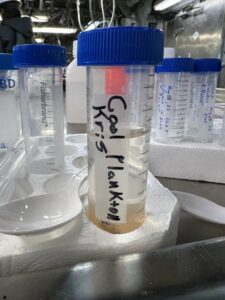
At least twice a year, scientists sample the deep ocean 200 miles offshore from Newport on the Shimada, aiming to dip nets at least 2,000 meters below the ocean’s surface.
“When we sample the Newport Line, it’s like home. I feel like the copepods know us. It’s like, ‘Hey! We’re here! We’re back!’” Fisher said, of the last night on May’s Shimada survey.
The hope to better understand the ocean drives the scientists onboard the Shimada.
“You never know what you’re going to find,” Fisher said. “We always find something interesting. There’s always something different. There’s always something that surprises us.”
Over the expedition, the nets brought up many surprises, including a deep sea bristlemouth, a bunch of pyrosomes, and bioluminescent copepods.
Each net dip felt like Christmas morning, Bauer said, the anticipation building as the net closed in on the surface. That Christmas-morning adrenaline kept him from sleeping more than a few hours each day on his first Shimada survey in 2020. “There was too much to see,” Bauer said.
“Everybody’s eyes light up when we bring up the nets,” Bauer said. “It’s like, let’s go out 200 miles and drop a net in the water and see what we get.”
What they get could one day help answer the mysteries of the deep, Bauer said.
- Courtney Flatt is a reporter for Northwest Public Broadcasting based in Richland, Wash. who traveled with researchers aboard the Bell M. Shimada during its trip off the Oregon coast in May.



